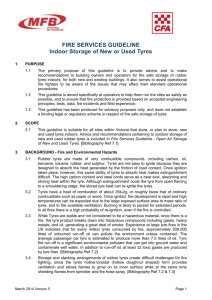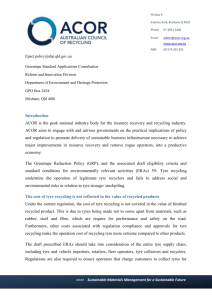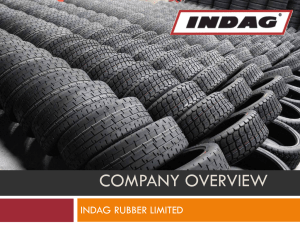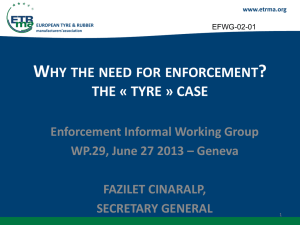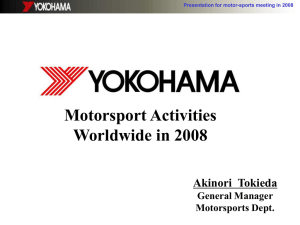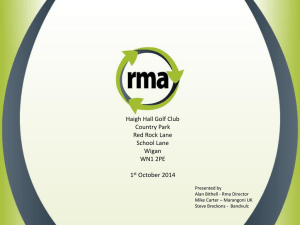Text version (WORD 591k)
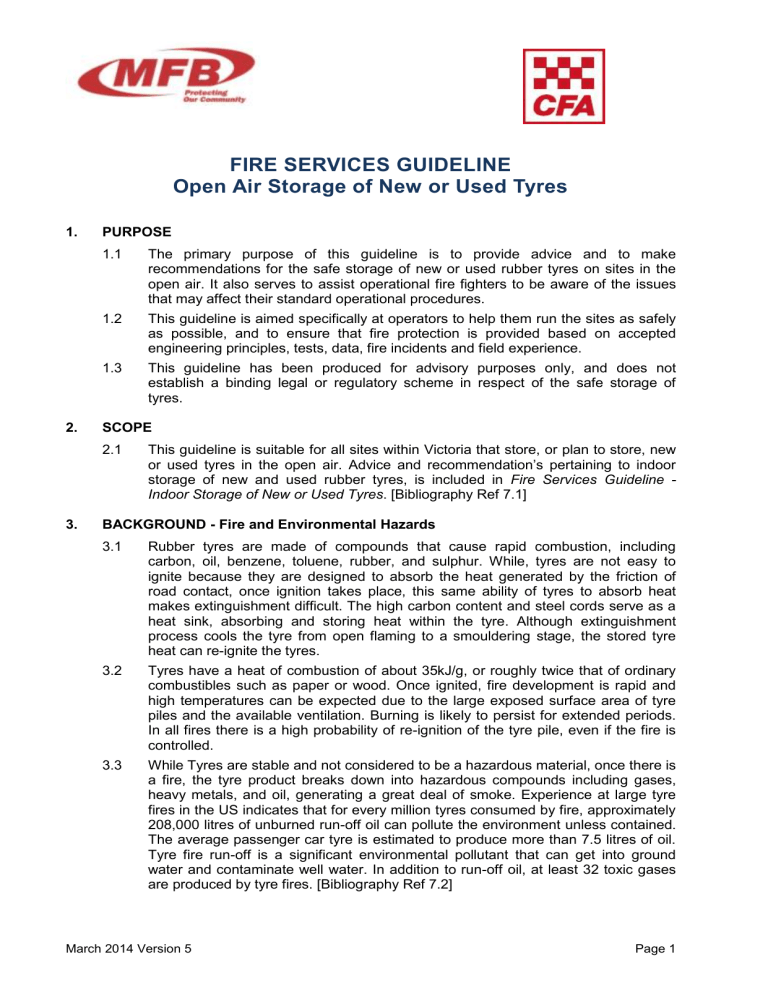
FIRE SERVICES GUIDELINE
Open Air Storage of New or Used Tyres
1. PURPOSE
1.1 The primary purpose of this guideline is to provide advice and to make recommendations for the safe storage of new or used rubber tyres on sites in the open air. It also serves to assist operational fire fighters to be aware of the issues that may affect their standard operational procedures.
1.2 This guideline is aimed specifically at operators to help them run the sites as safely as possible, and to ensure that fire protection is provided based on accepted engineering principles, tests, data, fire incidents and field experience.
1.3 This guideline has been produced for advisory purposes only, and does not establish a binding legal or regulatory scheme in respect of the safe storage of tyres.
2. SCOPE
2.1 This guideline is suitable for all sites within Victoria that store, or plan to store, new or used tyres in the open air. Advice and recommendation’s pertaining to indoor storage of new and used rubber tyres, is included in Fire Services Guideline -
Indoor Storage of New or Used Tyres . [Bibliography Ref 7.1]
3. BACKGROUND - Fire and Environmental Hazards
3.1 Rubber tyres are made of compounds that cause rapid combustion, including carbon, oil, benzene, toluene, rubber, and sulphur. While, tyres are not easy to ignite because they are designed to absorb the heat generated by the friction of road contact, once ignition takes place, this same ability of tyres to absorb heat makes extinguishment difficult. The high carbon content and steel cords serve as a heat sink, absorbing and storing heat within the tyre. Although extinguishment process cools the tyre from open flaming to a smouldering stage, the stored tyre heat can re-ignite the tyres.
3.2 Tyres have a heat of combustion of about 35kJ/g, or roughly twice that of ordinary combustibles such as paper or wood. Once ignited, fire development is rapid and high temperatures can be expected due to the large exposed surface area of tyre piles and the available ventilation. Burning is likely to persist for extended periods.
In all fires there is a high probability of re-ignition of the tyre pile, even if the fire is controlled.
3.3 While Tyres are stable and not considered to be a hazardous material, once there is a fire, the tyre product breaks down into hazardous compounds including gases, heavy metals, and oil, generating a great deal of smoke. Experience at large tyre fires in the US indicates that for every million tyres consumed by fire, approximately
208,000 litres of unburned run-off oil can pollute the environment unless contained.
The average passenger car tyre is estimated to produce more than 7.5 litres of oil.
Tyre fire run-off is a significant environmental pollutant that can get into ground water and contaminate well water. In addition to run-off oil, at least 32 toxic gases are produced by tyre fires. [Bibliography Ref 7.2]
March 2014 Version 5 Page 1
3.4 Storage and stacking arrangements of rubber tyres create difficult challenges for fire fighting, since the tyres hollow toroidal (hollow doughnut shaped) form provides ventilation and allows flames to grow on its inner surface while at the same time shielding flames from sprinkler and fire hose spray. [Bibliography Ref 7.2 & 7.3]
3.5 The many ways tyres may be stored outdoors make it impossible to apply any single or set of rules that cover all circumstances adequately. In general the provision of automatic fire protection is impractical for outdoor storage. Emphasis is therefore placed upon:
Adequate separation distance from site boundaries and buildings to resist the spread of fire
Where in a Bushfire Prone Area (BPA) adequate bushfire protection, with the design limiting received radiant heat flux level from a passing bushfire to a maximum of 12.5 kw/m 2
Limiting pile sizes and providing access between piles to restrict the fire size and facilitate effective fire fighting operations
Effective fire prevention practices to minimise the risk of fire
Protection of the environment from damage in the event of a fire
4. PLANNING RECOMMENDATIONS
4.1 Site Selection
4.1.1 It is important for operators to liaise with all relevant authorities and interested parties over proposals for new storage sites. These include:
The Metropolitan Fire Brigade (MFB) or
The Country Fire Authority (CFA)
The appropriate Planning Authority (usually Local Council)
The Environment Protection Authority (EPA)
WorkSafe Victoria
4.1.2 An ideal site for the storage of tyres will not be within the catchment area of any water used for water supply purposes, or where there may be a risk of ground water contamination, should a fire occur.
4.1.3 The site should also be on flat or gently undulating land, have soil with low levels of salt, have access to an adequate supply of salt free water, be devoid of dense vegetation and trees, have no overhead power lines, and not located in environmentally sensitive areas.
4.1.4 Priority should be given to locating potential storage sites outside of a Bushfire
Management Overlay (BMO).
4.1.5 Consideration of siting should be made with reference to prevailing wind conditions, particularly if the proposed site is near residential, health/care facilities, industrial or commercial developments. The proximity of major infrastructure such as roads, railways, navigable waterways, water reservoirs/dams storing potable drinking water, airports, etc., should be considered if dense smoke and toxic products of combustion from a fire could obscure travel routes or adversely impact the health and safety of neighbours. When considering siting with respect to prevailing winds, designers should also consider the impact that a tyre fire could have with regard starting secondary fires in nearby forest/woodland or significant bushland, as a result of fire brands/embers being carried in the prevailing winds from the initial fire location.
4.1.6 Disused quarries, sandpits, natural crevices, etc, which promote deep pile storage of tyres, should be avoided.
4.1.7 An impervious layer should also be applied to sites with pervious soil.
4.2 Tyre Pile Size and Separation Distances
March 2014 Version 5 Page 2
4.2.1 Storage pile sizes should be minimised to restrict the available fuel in the event of a fire.
4.2.2 Long and narrow tyre piles should be employed in preference to large square piles.
Maximum pile dimensions of 20m long x 6m wide x 3m high is recommended.
4.2.3 The separation distances provided by aisles between individual piles should be designed to inhibit fire spread due to radiant heat and/or direct flame contact during adverse windy conditions. Adequate aisle dimensions are critical for safe fire fighter access during the deployment of hose streams for exposure protection and where possible fire extinguishment, and for the operation of excavation equipment. A minimum separation distance of 20m between piles is recommended, but is not guaranteed to prevent fire spread.
4.2.4 Storage pile heights should be determined by the stability of the pile, both for normal storage conditions and in the event of a fire, and must not exceed 3m.
4.2.5 Separation distance of the storage piles to buildings will depend on the building construction. For buildings without appropriate fire resistant construction, this distance should not be less than 20m to allow for fire fighter access and to help prevent fire spread to adjacent buildings. This distance could be reduced on a case by case basis, as part of a fire risk assessment, if the building is constructed of appropriate fire resistance levels.
4.2.6 Separation distance to boundaries facing public roads should be not less than 6m and not less than 20m to the far boundary of the public road. Separation distance between the edge of storage piles to other boundaries should be no less than 20m.
Where in a BPA however, this separation distance may need to be increased as a function of satisfying the required bushfire protection measures of not exceeding a received radiation of 12.5 kW/m 2 .
4.2.7 Any increases in recommended pile dimensions or decreases in recommended separation distances should be assessed as part of a fire risk assessment as detailed in Part 5 of this guideline.
4.3 Ignition Source Control
4.3.1 It is recommended that operators develop and document procedures to control possible ignition sources on site, which should include as a minimum:
A hot work permit procedure for all cutting, welding, grinding type activities
Regular inspection and repair of electrical equipment, vehicles, machinery, security fences, etc.
Maintain site clear of fine fuels or minimise the accumulation of fine fuels from around stored tyres
Restriction of smoking to designated areas
No open fires
No storage of other flammable or combustible materials, hazardous materials or other easily ignitable material within 30m of any tyre storage.
Maintain separation distances to buildings and boundaries.
4.4 Security
4.4.1 The perimeter of the site should be surrounded by a firmly anchored fence or other effective method of security which prevents unauthorised access and is constructed to discourage entry.
4.5 Fire Protection
4.5.1 Operators should provide first aid fire fighting equipment for use by staff which may include water and foam fire extinguishers, water and foam hose reels, etc.
Research indicates that early extinguishment of a tyre fire may be possible in the first five minutes using water, Class A foam or wetting agents. Staff should be provided with appropriate training on the use, limitations, maintenance, etc., of the
March 2014 Version 5 Page 3
equipment provided. Refer to Appendix 1, which was developed from the source document at Bibliography Ref 7.2.
4.5.2 Operators should provide a hydrant system compliant with the provisions of AS
2419.1 and maintained in accordance with AS 1851
– Section 4. [Bibliography Ref
7.4]
4.5.3 For sites that comply with the maximum recommended pile dimensions and minimum separation distances, sufficient firewater for exposure protection and fire extinguishment may be provided by a fire hydrant system designed and installed in accordance with AS2419.1-2005 and the NCC Volume 1 [Bibliography Ref 7.12].
This should be confirmed by the operator as part of the site fire risk assessment
4.6 Water Supplies
4.6.1 The quantities of fire water and foam required to manage the identified fire scenarios for the site, as well as the equipment required to deliver the fire water and foam, should be determined by performing a site fire risk assessment, as detailed in
Part 5 of this guide.
4.6.2 Where town water is unavailable or insufficient, an adequate static water supply of a minimum of 2 x 250,000L tanks located in diagonally opposed positions on site is recommended. Fire pumps for stockpiles in remote locations needs to be considered. The location and capacity of pumps and tanks should be determined as part of a site fire risk assessment, in conjunction with the Fire Services.
4.6.3 Water provided for fire systems should be potable or Class A recycled water and should be salt free, due to the production of dioxins. [Bibliography Ref 7.5]
4.7 Site Containment of Contaminated Firewater, oil and liquid by-products of combustion
4.7.1 An impervious layer should be applied to sites with pervious soil. [Bibliography Ref
7.11]
4.7.2 Bund walls or catchment pits should be provided to contain surface run off from the site during fire fighting activities. The containment capacity should be determined as part of the site fire risk assessment and in conjunction with the responding fire service. Note that the required containment capacity is likely to exceed that required by EPA Bund Guideline, Bibliography Ref 7.11.
4.7.3 Emergency response procedures developed by the operator should include the use of excavation equipment such as bulldozers, excavators, etc, to separate unburnt tyres from the burning pile and to build containment berms and oil run off ponds.
4.7 Access for fire brigade appliances
4.7.1 Access for emergency vehicles should be provided as detailed in Fire Services
Safety Guidelines. [References 7.6 and 7.7]
4.7.2 Large sites should have at least two separate and opposing entry points for fire appliance access.
5. Fire Risk Assessment
5.1 The fire risk assessment should be performed in consultation with the relevant fire authority. The fire risk assessment should also be performed in consultation with appropriately qualified and / or experienced consultants
5.2 The fire risk assessment will determine all fire hazards at the site, determine the likelihood that a fire will occur, then determine the consequences of the nominated fire incidents, in terms of life safety, property protection and the environment.
5.3 The fire risk assessment will determine all the resources and equipment required to manage the consequences of the identified fire scenarios.
March 2014 Version 5 Page 4
5.4 It is expected that, depending on site conditions, equipment available, emergency response procedures, available staff and level of training, etc, the fire risk assessment may require appropriate fire modelling and emission and dispersion modelling to determine possible off site extents of toxic products of combustion.
6. Emergency Preparedness
6.1 Emergency Plan
6.1.1 Operators should develop and document an emergency plan which includes all the matters contained in Appendix 2, which has been developed with reference to
Bibliography Ref 7.8. The emergency plan should be prepared in consultation with the responding fire service.
6.1.2 It is recommended that operators develop and document a tactical fire plan for the site that includes:
Location of fire hydrants, boosters, fire service tapping(s), fire pumps, static water tanks, etc.
Location of all first aid fire fighting equipment, including the location and quantity of stocks of Class A and Class B foam concentrate held
Fire fighting actions appropriate to the site
Control of fire fighting run off
Location of drains, isolation valves, etc
Location of access points to the site
Location of hazardous materials or dangerous goods stored on site
Deployment procedures for excavating equipment, operators, etc.
6.2 Emergency Procedures
6.2.1 Emergency procedures should be developed to cover all foreseeable emergencies for the site.
6.2.2 The emergency procedures should include, as a minimum:
The means of raising the alarm
Contact details of the emergency services, the EPA, etc.
Actions to be taken by employees in the event of an emergency
Deployment procedures for excavating equipment, operators, etc.
The operator ’s expectation of actions by the Fire Services
6.2.3 Emergency response procedures developed by the operator should include the use of excavation equipment such as bulldozers, excavators, etc, to separate unburnt tyres from the burning pile and to build containment berms and oil run off ponds.
6.3 Emergency Equipment
6.3.1 The operator should determine equipment required to contain and manage emergency incidents. For outdoor tyre storage sites this would include equipment such as bulldozers, excavators, tracked loaders, etc., which are required to separate unburnt tyres from the burning pile, and to build containment berms and oil run off ponds. Guidance is provided in Bibliography Ref 7.2.
6.3.2 For equipment that is not always available on site, appropriate arrangements should be in place with equipment suppliers and equipment operators, with deployment procedures developed.
6.3.3 Operators of excavation equipment should be trained in the use of Self Contained
Breathing Apparatus (SCBA), and operators should ensure that sufficient SCBA equipment is available and maintained at all times. Fire Services personnel will not operate on-site excavation equipment, or provide PPE for site equipment operators.
6.3.4 All staff, including equipment providers and operators, should be appropriately trained in the site emergency plan and emergency response procedures.
March 2014 Version 5 Page 5
7. Bibliography
Reference has been made to the following documents in preparation of this guideline:
7.1 Draft Fire Services Guideline – Indoor Storage of New or Used Tyres 2014
7.2 Special Report: Scrap and Shredded Tire Fires, US Fire Administration/Technical
Report Series, USFA-TR-093/December 1998
7.3 FM Global Property Loss Data Sheet 8-3, Rubber Tire Storage, January 2009.
7.4 AS2419.1-2005 Fire Hydrant Systems – System Design, Installation and
Commissioning
7.5 Fire Safety for Tyre Sites, Home Office/The Scottish Office, 1995
7.6 CFA Guidelines for Subdivision http://www.cfa.vic.gov.au/plan-prepare/subdivision/
Planning, available
7.7 MFB Guideline GL-13, Hardstand and Emergency Vehicle Access for Fighting
Appliances, 12 August 2008, and MFB Guideline GL-27, Planning Guidelines for
Emergency Vehicle Access and Minimum Water Supplies within the Metropolitan
Fire District, 14 April 2009 (available at http://www.mfb.vic.gov.au/Community-
Safety/Workplace/Fire-Safety-Guidelines.html
) at
7.8 Dangerous Goods Act 1985, Code of Practice for the Storage and Handling of
Dangerous Goods, 2013, WorkSafe Victoria
7.9 GL 013, General Guidelines for the Outdoor Storage of Used Tyres, Amendment A,
28 December 2005, South Australian Fire Services
7.10 Policy No 2, Guidelines for Bulk Storage of Rubber Tyres, Version 1.01, 21 April
2008, Structural Fire Safety Unit, NSW Fire Brigades
7.11 Bund Guideline, EPA Publication Number 347, December 1992 (available at www.epa.vic.gov.au
)
7.12 National Construction Code Series, Volume 1, Building Code of Australia, Class 2 to
Class 9 Buildings
March 2014 Version 5 Page 6
Appendix 1 TYRE PRODUCT COMBUSTION STAGES CHRONOLOGY, from Bibliography Ref
7.2
Stages of Tyre
Combustion
Time Whole Tyre Fire
Progress
Shredded Tyres Action
Ignition/Propagation
Stage
0 to 5 minutes
15 to 30 minutes
Compression Stage 30 to 60 minutes
Equilibrium/Pyrolysis and Smouldering
Stages
60 minutes and beyond
Active tyre burning of individual tyres but has not extended to the entire pile.
Once the fire extends to the pile, the flame spread is two square feet every five minutes
The top layers of the tyres will collapse on themselves. The visible flaming is reduced. The fire then is seated deep in the pile.
Fuel consumption and heat production equalizes.
Combustion is efficiently producing sufficient heat to consume most combustion products.
Downward pressure of the encompassing pile causes the run-off oil flow to increase.
Tyre shreds are readily ignited and involve the entire pile quickly.
Fire spreads along the surface of the pile very quickly.
Burns like coal pile with hot coal bed in center and a clay-like ash crust on top of pile.
Clay-like ash crust protects burning core from water stream penetration.
Early extinguishment with water, class A foam or wetting agents may be possible.
Separate unburned tyre/product from the burning pile, downwind first
Focus efforts on separation; build containment berms and oil run-off collection ponds.
Contain fire spread.
Contain run-off oil.
Option 1 – using the excavator separate burning debris into manageable piles and extinguish with fog streams.
Option 2 – allow tyre/product fire to burn until the pile can be buried.
March 2014 Version 5 Page 7
18
19
20
14
15
16
17
11
12
13
8
9
6
7
10
2
3
4
Appendix 2 Emergency Plan Content [Bibliography Ref 7.8] – The Emergency Plan should include the following:
1 Name, location, postal address and nature of operations
5
Detailed map of the facility and surrounding area detail
Inventory of stored materials
Min & Max number of persons expected at the facility
Infrastructure likely to be affected by an incident and details of possible off site impacts on neighbours, including residential, commercial and industrial premises
Emergency Planning assumptions
Description of measures to control the consequences of each hazard and major incident
Details of emergency contact personnel
Allocation of personnel for implementing the plan
Arrangements for mutual aid between adjacent facilities
Procedures for early warning to the emergency services of an incident
Details of on-site and off-site warning systems
Contact details for emergency services
Details of on-site communication systems
Details of emergency resources on site
Arrangement for obtaining additional external resources
Procedures for safe evacuation and muster of personnel
Details of control points and procedures for essential services
Procedures for containment of any incident
Procedures for decontamination following an incident
March 2014 Version 5 Page 8

